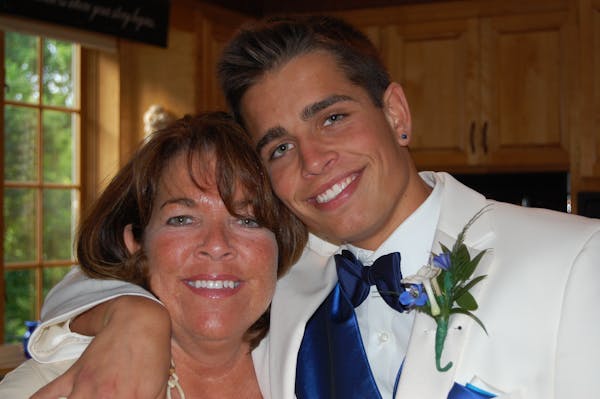Facing a steady climb in overdose deaths that has defied efforts to stem it, Hennepin County authorities are taking a new approach to the opioid epidemic with an education-focused campaign.
Last year saw a record 144 opioid-related overdose deaths. And with the drug now being laced with the powerful synthetic opioid fentanyl, Hennepin County Sheriff Rich Stanek and his colleagues say the situation is a crisis.
"We thought increased public awareness, among other things, would make a dent last year," he said Tuesday at a news conference. "But we just didn't do a good enough job."
Stanek, joined by U.S. Attorney Andrew Luger, school officials, members of the medical community and the mother of an overdose victim, announced the yearlong initiative to fight heroin "because every death is preventable," Stanek said.
Although officers and paramedics saved many lives last year by administering Narcan, a new drug that immediately reverses the effects of an overdose, Stanek said first responders can't do it alone.
"We need a group of partners to hit the problem head-on," he said. "We need prevention, intervention, law enforcement efforts and even more public awareness."
The new campaign has been dubbed #NOverdose.
To give the public an inside look at the heroin problem, Stanek's office will issue monthly updates on overdose prevention and fatal overdoses, drug drop-off efforts and feedback from town hall meetings.
He also will push the Legislature to make the state Board of Pharmacy's online prescription drug monitoring system mandatory for health care providers.
Statewide, opioid overdoses reached 355 in 2015. And the 2016 spike in fentanyl deaths was highlighted when Prince was found dead in an elevator in Paisley Park studios in April. He was part of a 31 percent increase in opioid deaths that saw victims ranging from 16 to 98 years old.
U.S. Sen. Amy Klobuchar said Tuesday that she will continue her national support of innovative efforts like #NOverdose, which she hopes will stop addiction before it starts.
She was one of four senators who led major bipartisan legislation to combat prescription drug abuse and helped push through funding for treatment and prevention.
'Tragically common'
Colleen Ronnei of Chanhassen thought she dodged a bullet when her son, Luke, appeared to shake a crippling heroin addiction last year. Funny, kind and handsome, the 20-year-old used the drug to deal with anxiety and depression. It only took a couple of days for Luke to become addicted after a friend introduced him to the drug.
He kept his addiction quiet for months, finding the stigma too shameful to handle, she said. But eventually he completed treatment and went off to college in Arizona, maintaining a high GPA and coming home every three weeks for continued help. But hours before an appointment last January, his parents found him dead in his bedroom.
"His story is tragically common," Ronnei said. "He didn't want to be the poster boy for this crusade."
Luke Ronnei's alleged heroin dealer, Beverly Burrell, 30, of Maplewood has been charged with five counts of third-degree murder in connection with five overdose deaths, part of ongoing efforts to get dealers off the streets.
Prosecuting heroin traffickers was a top priority for Luger when he took over as U.S. attorney about three years ago. Although his office has arrested many dealers and has a better handle on how the drug is coming into Minnesota, sellers keep meeting demand on the streets and on the internet, he said.
"Our enemies keep stepping it up a notch," Luger said. "But the sheriff and myself have attended several national conferences this year to learn what we might be seeing next."
Not a big-city problem
The epidemic isn't just a law enforcement or criminal justice issue, said Dr. Charles Reznikoff, an addiction specialist at Hennepin County Medical Center.
There are several ways the medical community can help to reduce heroin use, including educating doctors on how to deal with a patient with an addiction, taking a more cautious approach when prescribing pain medication and providing better access to treatment, he said.
"We have conquered other addictions, so we can handle this one," he said. "Recovery does happen."
Preventing temptation needs to start with junior and high school students, said Holly Magdanz of the Hopkins School District. Alcohol and marijuana are still the top abuse concerns for the student population, but opioids are making a push, she said.
"Most kids aren't using heroin, and they have to know either through education or their parents that they are in the majority," she said.
Campaigns such as #NOverdose can have a significant impact, Magdanz said. The anti-tobacco campaigns of the past 20 years have seen smoking and chewing among teenagers decline significantly, she said.
Eden Prairie Police Chief Jim DeMann emphasized that heroin isn't only a big-city problem. His department handled seven overdose deaths last year.
Because the county hadn't seen rampant heroin use in several decades, Stanek was hoping the spike in overdoses would be short-lived.
"But I know that's not the case," he said. "We will keep on fighting."
David Chanen • 612-673-4465

Trail section at one of Minnesota's most iconic spots closing for rehab

Will 'shotgun only' zone for deer in southern Minnesota be abolished?

Four Minnesotans catch salmonella in outbreak linked to basil sold at Trader Joe's

